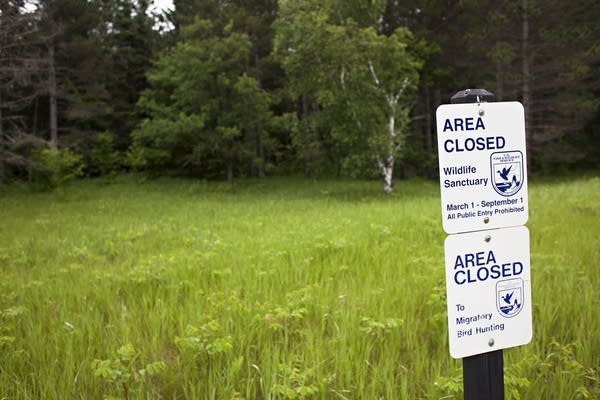Decoding frog sounds to understand why the populations are dropping

Go Deeper.
Create an account or log in to save stories.
Like this?
Thanks for liking this story! We have added it to a list of your favorite stories.
In a remote northern Minnesota forest, biologist Lowell Deede makes his way to a small wetland to check an electronic recorder.
It looks like a wildlife camera that people strap on trees. But instead of a lens, it has microphones sticking out each side like ears. The recorder captures the sounds of frogs, birds and other wildlife in the marshy spot for five minutes every hour, seven days a week.
Other devices monitor water and air temperature to help biologists look for signs of seasonal changes.
"How that changes behaviors or the life cycles of the insects, and how frogs respond to that, how wetlands respond to that," he said. "Without gathering the data, you're not going to be able to really tell."
Turn Up Your Support
MPR News helps you turn down the noise and build shared understanding. Turn up your support for this public resource and keep trusted journalism accessible to all.
The wetland is one of 10 on the refuge where scientists started collecting data seven years ago. Now that mating season is over, all of its wood frogs, spring peepers and chorus frogs are quiet.

But two months ago, it emitted a cacaphony of sound. From March to the fall freeze, Deede visits the site every 45 days to replace the recorder's batteries and memory cards.
Analyzing the memory cards can tell scientists when frogs are first active in the spring, and when mating season peaks. They can also gauge frog populations.
Data collected from 34 sites across North America allowed researchers to quantify the decline in frog populations for the first time. They found that between 2002 and 2011 all frog populations were down nearly four percent. Populations of species considered at risk fell nearly 12 percent.
U.S. Geological Survey research ecologist Michael Adams, the study's lead author, was surprised to find even frog species considered healthy lost population.

"This measure of an overall decline in those species for the places that we're monitoring is the thing that was the most alarming in the study and that adds to our concern for what's going on with amphibians," Adams said. "There's still something else going on beyond what we knew was going on with the more critically endangered species."
Adams said disease, contaminants like pesticides and habitat loss are primary reasons frog populations are shrinking.
But scientists still don't understand why it's happening, said Adams, who notes that there might be different explanations for declining frog populations in Minnesota, Colorado or California.
That's why long-term monitoring at sites across North America is so important, he said.
"It's unusual to have ecological research projects that run for a long time," Adams said. "It allows us to ask types of questions you can't normally ask over shorter time frames."

The information collected at more than 30 sites will help scientists see a big picture of frog populations and climate change. But it will also help better identify changes happening at each location so managers can try to reduce the effect on wildlife.
Besides the on-the-ground information, scientists monitor satellite images to track snowmelt and when the landscape turns from brown to green each spring.
Over the past 10 years, Deede has noticed fewer spring peepers calling at the refuge. But he's not ready to blame that on climate change. He said it will likely take many more years of data for scientists to begin understanding the complex changes happening on the landscape.
"This data here is one element to a much larger data collection process that's ongoing," he said.


